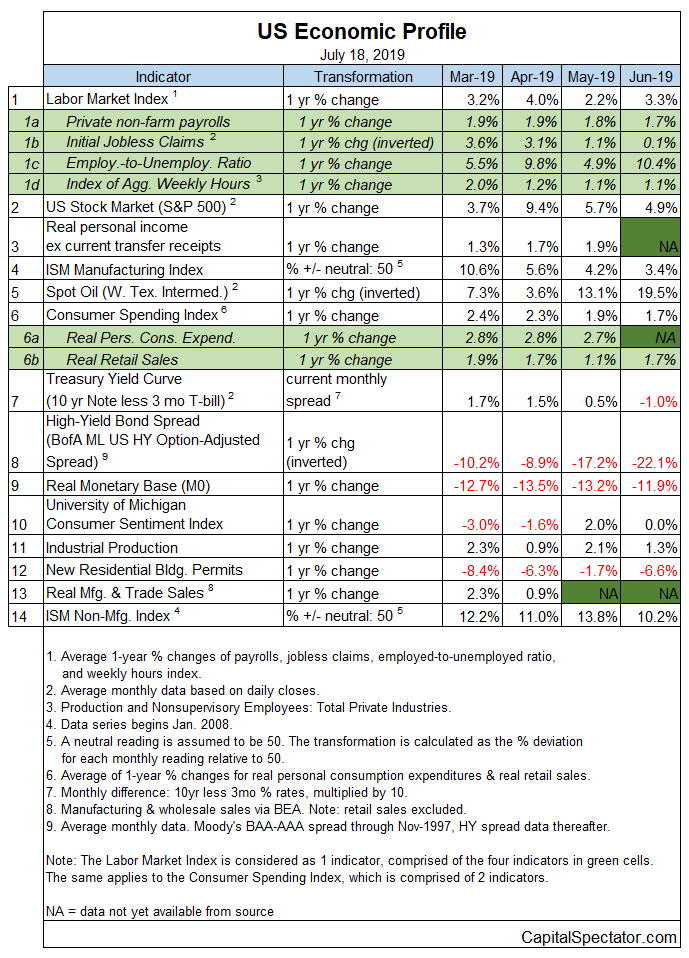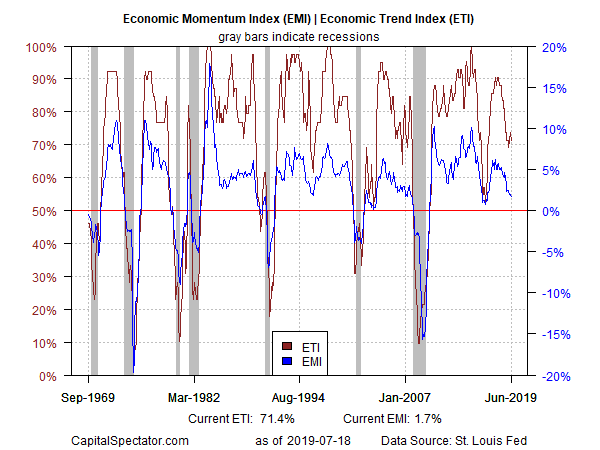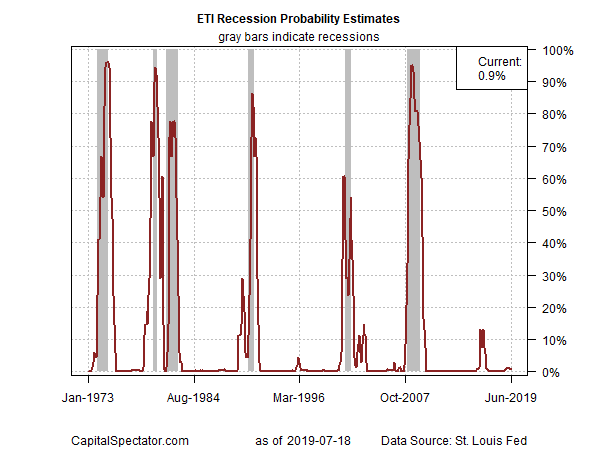How slow can it go before slipping into recession? Economic growth in the U.S. has decelerated in recent months and there are new signs in today’s update that the macro trend is at risk of continuing to lose speed (gradually) in the months ahead. Thus the critical question: Where does the tipping point lie? Unclear, although the potential for trouble is creeping higher.
Using the latest numbers, today’s update shows that the slowdown continued to deteriorate (slightly) vs. last month’s update. Notably, the June profile’s near-term projection reflected the possibility of a mild reacceleration in growth. A month later, the prospect for a rebound in the trend has faded, based on today’s revised economic profile. As shown in the last chart below (Economic Trend Index: Actual Vs. Estimates), this month’s update reflects a fractionally softer outlook for the US economic trend, in the wake of the latest economic releases.
The good news is that an NBER-defined recession hasn’t started and is unlikely to kick in for the immediate future (through August). Looking into September and beyond is considerably less clear and so the possibility can’t be dismissed that the macro trend will deteriorate further in the final months of the year, perhaps to the point of triggering a new downturn.
For now, slow growth remains the working assumption, a view that’s based solely on the numbers published so far (along with some cautious modeling for projecting the missing data and looking ahead through August). Echoing this view is a nowcast for the upcoming second-quarter report on gross domestic product (due on July 26) that expects a substantially softer gain vs. Q1’s strong 3.1% advance. As reported by The Capital Spectator last week, the median estimate for Q2 GDP growth (based on a set of nowcasts) calls for a weak 1.7% increase. More recent estimates remain in line with that outlook, including yesterday’s revised GDPNow model (via the Atlanta Fed), which projects a sluggish 1.6% gain in output for the April-through-June period.
The best we can say at this point is that a new recession isn’t imminent. The analysis draws on a diversified set of indicators through June, based on The Capital Spectator’s proprietary business-cycle model. Analyzing the data in the table below through this lens still reflects a low probability that an NBER-defined downturn has started.


For additional context, consider the aggregated profile of the indicators in the table above via two benchmarks. The Economic Trend Index (ETI) – a business-cycle index that tracks 14 indicators that collectively capture a broad snapshot of US economic activity – shows a renewed downside bias. ETI dipped slightly for June from the previous month, settling just above 71% (red line in chart below). This reading is still well above the 50% tipping-point mark (readings below 50% indicate recession). Note, however, that filtering the same data set through another econometric lens – the Economic Momentum Index (EMI) – reflects a weaker trend and one that appears to be deteriorating at a faster pace. EMI is still moderately above its 0% tipping point, but the downside bias is worrisome and deserves close attention in the weeks ahead.
Using the data published to date for ETI, however, continues to offer a strong sign that recession risk remains low in the rear-view mirror. Translating the index’s historical values into recession-risk probabilities with a probit model points to low business-cycle risk for the US through last month. Analysis through this lens indicates that the odds remain virtually nil — roughly 1% — that NBER will declare June as the start of a new recession. Note, too, that a probit-model reading of EMI (not shown) also shows a low probability (6%) that the economy was contracting last month.

Turning to the near-term outlook, consider how ETI may evolve as new data is published. One way to project values for this index is with an econometric technique known as an autoregressive integrated moving average (ARIMA) model, based on default calculations via the “forecast” package in R. The ARIMA model calculates the missing data points for each indicator for each month — in this case through August 2019. (Note that April 2019 is currently the latest month with a complete set of published data for ETI.) Based on today’s projections, ETI is expected to tick down in August, albeit to a level that still reflects modest economic growth.

Forecasts are always suspect, but recent projections of ETI for the near-term future have proven to be reliable guesstimates vs. the full set of published numbers that followed. That’s not surprising, given ETI’s design to capture the broad trend based across multiple indicators. Predicting individual components in isolation, by contrast, is subject to greater uncertainty. The assumption here is that while any one forecast for a given indicator will likely be wrong, the errors may cancel out to some degree by aggregating a broad set of predictions. That’s a reasonable view, based on the generally accurate historical record for the ETI forecasts in recent years.
The current projections (the four black dots in the chart immediately above) suggest that the economy will continue to expand through next month, albeit at a sluggish pace. The chart also shows the range of vintage ETI projections published on these pages in previous months (blue bars), which you can compare with the actual data (red dots) that followed, based on current numbers.
